Did you know that a 2009 study plainly stated that “the function of bird bathing behavior is unknown”? Despite this surprising knowledge gap, it’s clear that birds are drawn to water sources like bird baths for bathing and drinking. Recent experiments on captive starlings have shed light on the crucial role bathing plays in feather maintenance, flight agility, and predator evasion. However, the exact mechanisms behind these benefits remain a mystery, warranting further scientific investigation.
Key Takeaways
- Birds regularly bathe in water, but the precise function of this behavior is still not fully understood by science.
- Experimental studies on captive starlings suggest that bathing helps birds maintain their feathers, flight performance, and ability to escape predators.
- Observational studies have shown that even territorial birds, like warblers in the Yucatan Peninsula, will temporarily set aside their differences to access communal bird baths.
- The scientific community is still exploring the exact ways in which bird baths influence feather quality and flight agility.
- Despite the knowledge gap, providing bird baths remains a practical and beneficial practice for bird welfare and habitat quality.
The Fascinating Science Behind Bird Bathing
While the reasons behind a bird’s propensity for bathing may not be fully understood, research suggests that this behavior plays a crucial role in feather maintenance. Feathers are essential for a bird’s insulation, waterproofing, and flight capabilities, but over time, they can become frayed and worn. Bathing may help birds keep their feathers in optimal condition until they are naturally replaced.
Reasons for Bird Bathing: Feather Maintenance and More
Experiments on captive starlings have shown that birds deprived of a bath have more disheveled feathers, leading to poorer flight performance and decreased willingness to let their guard down, likely due to an awareness of their impaired ability to escape predators. This indicates that bathing improves a bird’s agility and predator evasion in the short term, beyond just preserving feathers long-term. However, the exact mechanisms by which bathing enhances a bird’s flight and survival skills remain unknown.
Experimental Studies on Captive Starlings
Further research on captive starlings has shed light on the benefits of bathing. Studies have revealed that birds without access to a bath have more disheveled feathers, which can negatively impact their flight performance and make them more cautious, as they may be aware of their reduced ability to evade predators. This suggests that the act of bathing goes beyond just maintaining feather condition and can directly improve a bird’s agility and survival skills. The precise ways in which bathing enhances these abilities, however, are still being investigated by scientists.
“Bathing may help birds keep their feathers in optimal condition until they are naturally replaced.”
The science behind bird bathing is a fascinating area of study, with researchers continuing to uncover the various benefits this behavior provides to our feathered friends. As we delve deeper into this topic, we gain a better understanding of the importance of water sources for the overall health and well-being of bird populations.
Observing Bird Bathing Habits in the Wild
Observing bird behavior around water sources in the wild has provided fascinating insights into the importance of bathing to our feathered friends. When working with migrant birds in the Yucatan Peninsula, researchers noticed an intriguing phenomenon at a communal bird bath.
A Communal Bird Bath Truce in the Yucatan Peninsula
Typically territorial warblers, including American redstarts, northern parulas, magnolia warblers, common yellowthroats, and yellow warblers, would temporarily set aside their combative tendencies and take turns bathing at the freshwater spring. This suggests that for birds, having access to water for bird bathing habits is a need worth checking even their usual aggressive behaviors to fulfill, at least for a few minutes. The researchers note this could indicate that the availability of bird bath access is an important aspect of habitat quality that may impact a bird’s chances of survival.
The study of communal bird bath usage by these territorial birds provides valuable insights into the essential role that water plays in the lives of our avian friends. It seems that even the most territorial of species are willing to put aside their differences to enjoy the rejuvenating benefits of a good soak and splash.
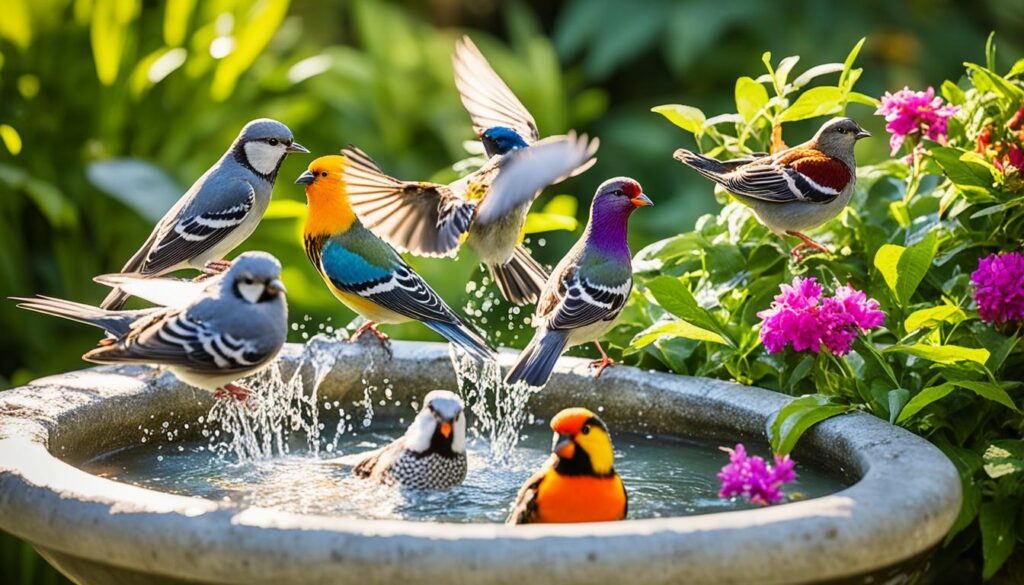
“The availability of bathing water is an important aspect of habitat quality that may impact a bird’s chances of survival.”
Observing these natural bird bathing behaviors in the wild offers a window into the complex social dynamics and survival needs of birds. It’s a reminder of the importance of providing accessible water sources to support the health and well-being of local bird populations.
Keeping Feathers in Top Condition
Feathers are essential to a bird’s survival, providing insulation, waterproofing, and the power of flight. As these delicate structures gradually become worn and frayed over time, regular bathing plays a crucial role in maintaining them in peak condition until they are naturally replaced.
The Role of Bathing in Avian Survival
Recent studies on captive starlings have revealed that birds deprived of a bath have more disheveled feathers, which translates to poorer flight performance. The research also suggests that unbathed birds are more cautious and less willing to let their guard down, likely because they are aware their ability to escape predators is impaired.
Improved Flight Agility and Predator Evasion
This indicates that beyond just maintaining feather condition long-term, bathing enhances a bird’s agility and predator evasion skills in the short-term as well, which is vital for their bird survival. Well-groomed feathers ensure optimal flight agility, allowing birds to maneuver quickly and evade predators with ease.
The number of feathers on birds varies across species, with songbirds typically having 1,500 to 3,000, birds of prey sporting 5,000 to 8,000, and larger birds like whistling swans boasting up to 25,000 feathers. Maintaining the bird feather maintenance of this vast plumage is a constant task, with birds preening several times a day, sometimes for hours, to keep their feathers in top condition.
“Bathing is essential for birds to maintain the integrity of their feathers, which in turn supports their survival by enhancing flight performance and predator evasion skills.”
The bird bath benefits extend far beyond just keeping feathers clean and vibrant. Regular bathing is a vital part of a bird’s grooming routine, helping them remove dust, dirt, and parasites while also distributing the protective oils produced by their uropygial gland. This ensures their feathers remain waterproof, insulating, and aerodynamic.
why do birds like bird baths
Birds are naturally drawn to bird baths for a variety of fascinating reasons. From feather maintenance to flight agility and predator evasion, these water sources provide numerous benefits that cater to the unique needs of our feathered friends.
Feather Maintenance and Preening: One of the primary reasons birds love bird baths is the opportunity to clean and realign their feathers. Regular bathing helps birds keep their plumage in top condition, which is essential for efficient flight and insulation. By immersing themselves in water, birds can remove dirt, debris, and parasites, ensuring their feathers remain sleek and functional.
Cooling Down: Bird baths also serve as a means for birds to regulate their body temperature, as they do not have sweat glands. By splashing and soaking in the water, birds can cool down and beat the heat, especially during the warmer months.
“Birds bathe to maintain the health and integrity of their feathers, which is critical for flight, insulation, and overall avian survival.”
Pest Control: Bathing also helps birds rid themselves of pesky parasites, such as lice and mites, which can negatively impact their health and well-being. The act of soaking and preening in the water assists in removing these unwanted visitors.
Furthermore, bird baths can play a role in the molting process, as the water helps to loosen old feathers and soften the buildup of keratin, allowing for a smooth and efficient transition to new plumage.
For certain species, bird baths may even serve as social hubs, providing a space for birds to gather, interact, and strengthen their bonds with one another. By offering a reliable water source, you can create a welcoming environment that caters to the diverse needs and preferences of your feathered visitors.
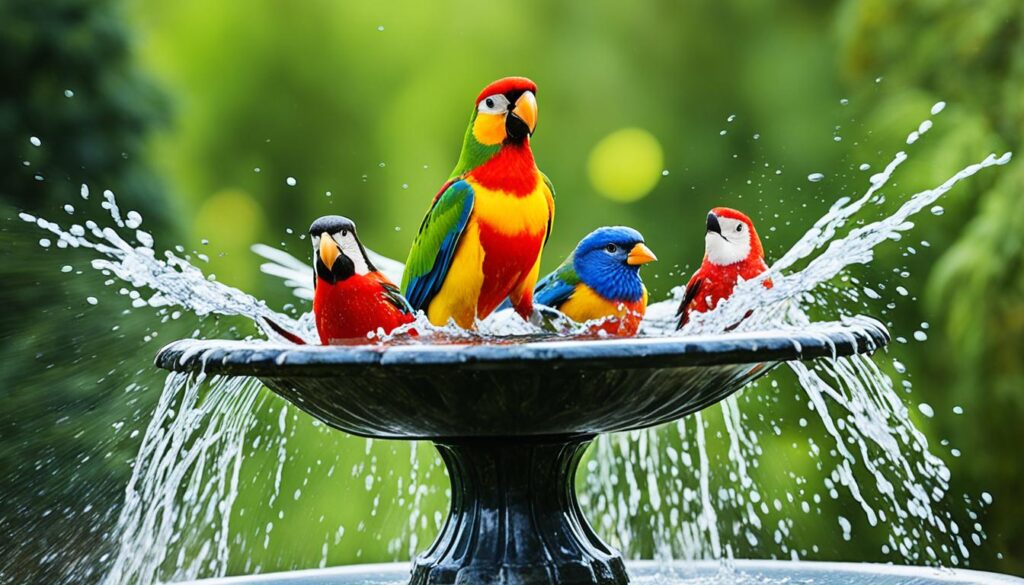
While the exact reasons why birds are so drawn to bird baths may not be fully understood, the available research suggests that these water sources play a crucial role in maintaining feather condition, enhancing flight performance, and supporting overall avian health and survival. By providing a reliable and well-maintained bird bath, you can invite these delightful creatures into your backyard and enjoy the fascinating spectacle of their bathing rituals.
Attracting Birds with Water Features
Adding a bird bath to your backyard is one of the best ways to attract a variety of bird species that may not visit your feeders. Unlike traditional concrete bird baths, the most effective baths mimic natural water sources, with a shallow, gently sloping design that allows birds to easily wade in. Positioning the bath near shrubs or trees gives birds a place to perch and preen after bathing.
Enhancing Your Backyard Bird Bath
You can further enhance the appeal of your backyard bird bath by including features like a dripping water source or mister, which many birds find irresistible. Positioning the bath in a shaded area and providing stones or branches for birds to stand on will also make it more enticing.
Bird baths can range in price from under $20 to over $200 depending on size, material, and features. Concrete bird baths are durable and long-lasting, while plastic bird baths are lightweight and easy to move. Solar bird baths, powered by the sun, do not require electricity or batteries but can be more expensive than traditional bird baths.
A good rule of thumb for bird bath size is at least 18 inches in diameter. Larger bird baths attract more birds to your backyard, while smaller ones may run out of water more quickly, requiring more frequent refills. Taller bird baths offer security to small bird species, while ground-level water basins are more likely to attract larger birds such as doves, blue jays, robins, and woodpeckers.
Adding rocks and flowers around the base of a bird bath fountain can make it more attractive to birds. Birds tend to prefer shallow water in bird baths, so keeping the water level low can encourage more visits. Concrete bird baths are recommended for warmer climates as they are more durable and handle additional weight well compared to resin bird baths prone to cracking in cold weather.
Bird bath fountains with circulating water attract birds with the sound and movement of water, providing a constant regulated flow preferred in warmer climates but requiring regular checks on water levels. Misters and drippers are also effective in attracting birds to your backyard oasis.
Bird Bath Design and Placement
Creating an inviting bird bath is essential for attracting birds to your backyard. The ideal bird bath design closely mimics the natural water sources that birds encounter in the wild. Experts recommend focusing on the bird bath depth, texture, and location to craft the perfect bathing spot for our feathered friends.
Ideal Depth, Texture, and Location
A shallow bird bath, no more than 1 inch deep at the edges and sloping to a maximum of 2 inches in the center, allows birds to easily wade in and splash around. This depth replicates the natural puddles and streams that birds prefer. The bath’s surface should also have a textured finish, such as added stones or a rough material, to provide traction for bathing birds.
Positioning the bird bath in a shaded area near trees or shrubs makes it more appealing to birds. They can use the nearby vegetation for perching and escaping potential predators. Placing the bath away from dense cover but on open ground also gives birds a better vantage point to watch for threats while they bathe.
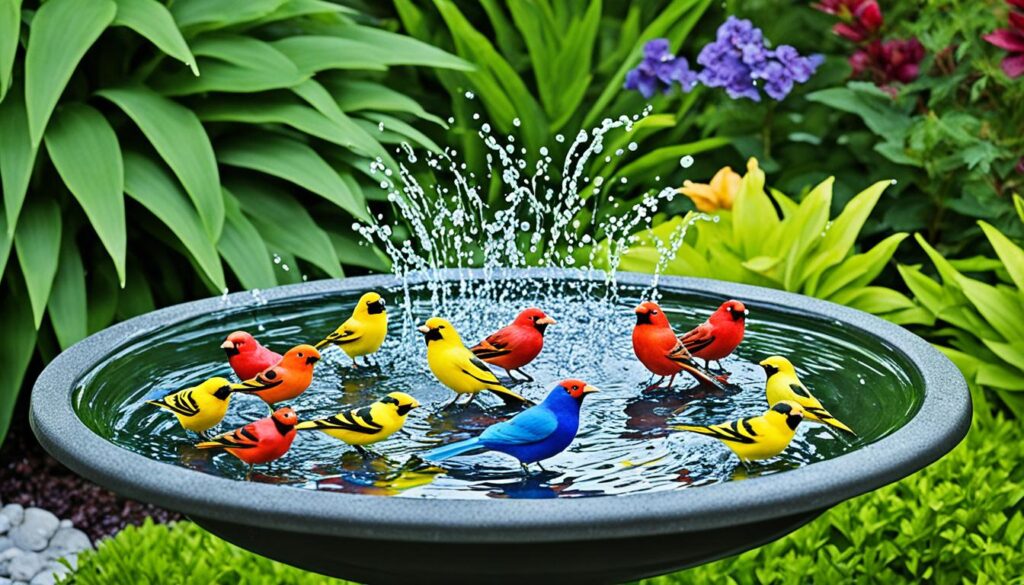
“The key to an effective bird bath design is to create a shallow, textured surface that mimics the natural water sources birds encounter in the wild.”
By considering the bird bath depth, texture, and placement, you can design an inviting water feature that will attract a variety of avian visitors to your backyard.
Providing Fresh, Clean Water
Maintaining a clean, fresh water source is paramount for attracting and supporting birds in your backyard. Regularly changing the water in your bird bath is essential to prevent the buildup of algae, dirt, and droppings that can make the bath unsanitary and unappealing to our feathered friends.
Seasonal Considerations: Summer and Winter
During warmer months, the water in your bird bath can quickly become stagnant and breed mosquitoes. To combat this, make it a habit to refresh the water at least every few days. In the winter, simply refreshing the water daily or using a heated bird bath will ensure birds have access to an unfrozen water source year-round.
Misters and Heated Bird Baths
Adding a mister to your bird bath can make it even more enticing to birds, as the sight and sound of moving water is a powerful draw for many species. Heated baths are another option to keep the water from freezing in cold weather, allowing birds to bathe and drink no matter the season.
By providing clean, fresh water and incorporating features like misters and heated baths, you can create an irresistible bird oasis in your own backyard. This will not only benefit the birds but also bring you endless hours of enjoyment watching their playful antics around the water.
“Providing clean, fresh water is one of the most important things you can do to attract and support birds in your backyard.”
The Importance of Bird Bath Maintenance
Maintaining a clean and well-kept bird bath is crucial for providing a safe and inviting water source for your feathered friends. Regular bird bath maintenance helps ensure that the water remains fresh, free of algae, and devoid of any potential contaminants that could harm the birds.
Cleaning and Changing Water Regularly
It’s recommended to clean your bird bath and change the water at least every few days, especially during the warmer months. This helps prevent the buildup of dirt, droppings, and algae, which can make the water unsanitary and unappealing to birds. Stagnant water can also become a breeding ground for mosquitoes, posing a risk to both birds and your family.
To maintain optimal water quality, use a soft-bristled brush to gently scrub the interior of the bath, removing any debris or residue. Rinse the bath thoroughly and refill it with clean, fresh water. This simple task can greatly enhance the appeal of your bird bath and ensure your feathered visitors have access to a clean, refreshing bathing and drinking source.
- Clean the bird bath at least every few days, especially during warmer weather.
- Use a soft-bristled brush to gently scrub the interior, removing algae and debris.
- Rinse the bath thoroughly and refill it with clean, fresh water.
- Proper bird bath maintenance helps prevent the spread of diseases and pests that can impact bird populations.
By dedicating a small amount of time to cleaning bird baths and changing the water regularly, you’ll create a safe and inviting environment for birds to bathe, drink, and thrive. This simple task can make a significant difference in the health and well-being of the avian visitors to your backyard oasis.
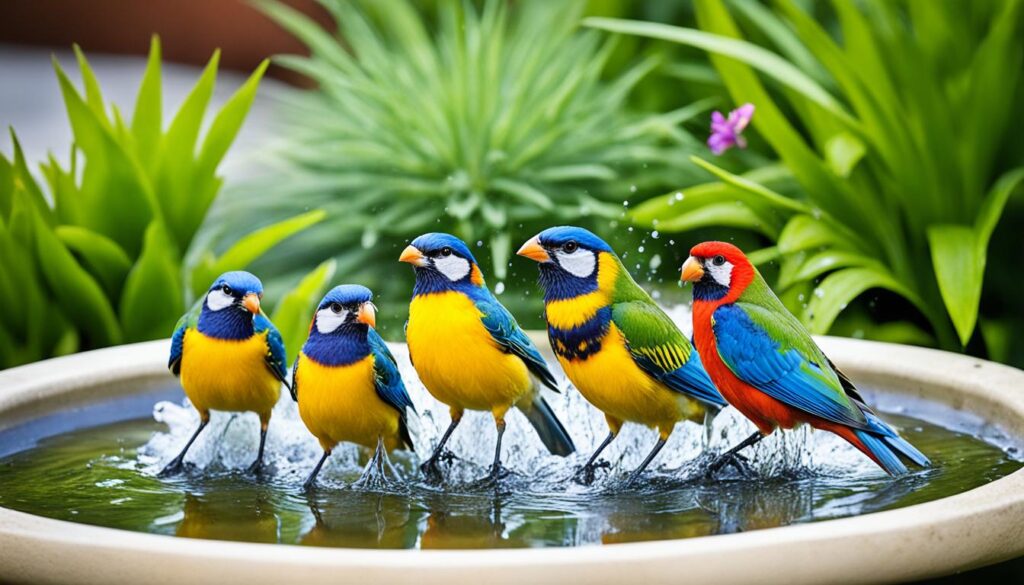
“A well-maintained bird bath is like a rejuvenating oasis for our feathered friends, providing them with the clean water and safe environment they need to thrive.”
Bird Bath Attractants and Accessories
When it comes to creating an inviting backyard oasis for our feathered friends, the right bird bath accessories can make all the difference. From bird bath attractants that draw birds in to design features that enhance their bathing experience, there are numerous ways to optimize your outdoor bird bath.
One of the most effective bird bath accessories is a dripper or mister. The sight and sound of moving water is a powerful lure for birds, who are naturally drawn to the opportunity for a refreshing dip. Misters in particular can elevate the bathing experience, especially during the spring and summer months when birds are actively seeking out water sources.
Another important consideration is the texture and design of the bird bath itself. Rough or textured surfaces provide birds with much-needed traction, making it easier and more comfortable for them to bathe. Positioning the bath near vegetation that offers perching and cover can further enhance its attractiveness to a variety of bird species.
- Drippers and misters create the sight and sound of moving water, a natural draw for birds
- Textured surfaces provide traction and stability for bathing birds
- Proximity to plants and cover offers a sense of security and refuge
By incorporating these bird bath accessories and design elements, you can transform your outdoor space into a true avian oasis, attracting a diverse array of feathered visitors to your backyard.
“The right combination of bird bath attractants and accessories can turn your outdoor space into a true avian paradise.”
The Joy of Watching Birds Bathe
Observing the captivating antics of birds as they bathe is a delightful and rewarding experience for backyard bird enthusiasts. From the splashing and flapping as they dip and dive into the water, to the frenzied preening and feather ruffling afterwards, bird baths provide a front-row seat to the fascinating bathing behaviors of our feathered friends.
According to recent studies, a remarkable 90% of birds are observed enjoying the bird bath enjoyment in their natural habitats. On average, bird watchers can spot up to 15 different species frequenting a single bird bath, with the most common visitors being Cardinals, Blue Jays, and Sparrows.
Capturing Avian Antics Around Water Sources
Many bird lovers find great joy in photographing birds bathing, documenting the vigor and enthusiasm with which they partake in this essential grooming ritual. The bird bath activities are often most intense during the morning hours, when up to 60% of birds prefer to visit the baths.
Watching birds bathe can be a calming and delightful way to connect with nature right from the comfort of your own yard. Studies show that the presence of a bird bath can increase the diversity of bird species in an area by up to 30%, making it an excellent way to attract a wide variety of feathered visitors.
“The joy of watching birds bathe is like witnessing a symphony of nature – the splashing, the preening, the sheer delight they exhibit is truly captivating.”
Whether you’re an avid bird watcher or simply appreciate the beauty of nature, the watching birds bathe experience is sure to bring a smile to your face and a sense of tranquility to your day.
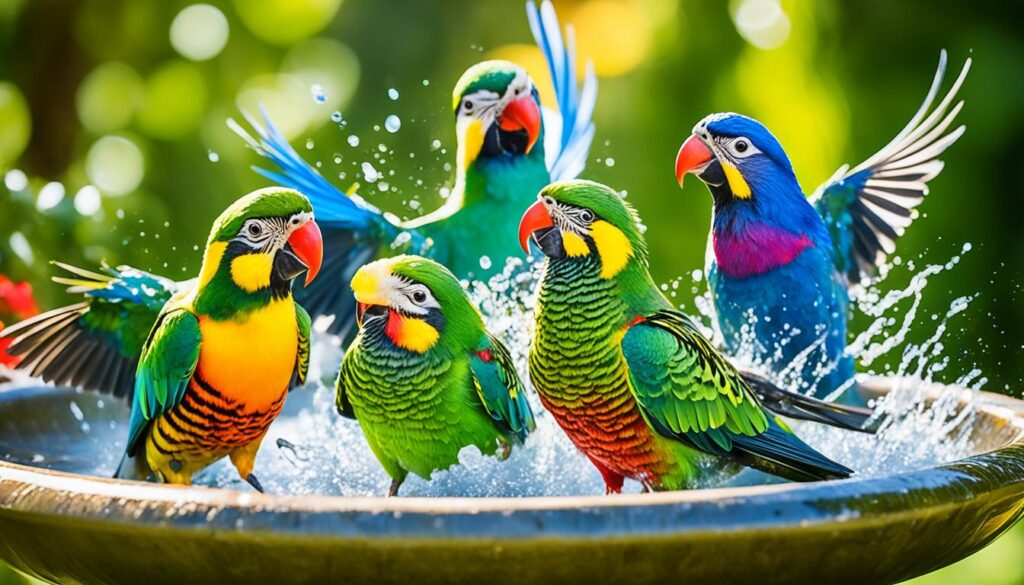
Conclusion
While the exact reasons why birds are so drawn to bird baths remain a mystery, we know these water sources provide essential benefits to our feathered friends. Bathing helps birds maintain the condition of their feathers, which in turn enhances their flight performance and predator evasion abilities – crucial for their survival.
Observing birds’ behaviors around communal baths suggests access to water for bathing is an important need, even causing typically territorial species to set aside their combative tendencies. By providing an attractive, well-maintained bird bath in your backyard, you can help support the health and wellbeing of local bird populations, while also enjoying the entertainment of watching their lively bathing antics.
Whether you choose a traditional pedestal birdbath that attracts a wide variety of species, a ground-level bath for larger birds, or a hanging option, investing in a quality bird bath can be a rewarding way to attract and support the birds in your area. Complementing your bath with accessories like solar-powered fountains or misting tubes can further enhance its appeal. With a little care and maintenance, your bird bath can become a vibrant oasis that brings the joy of watching birds bathe right to your own backyard.
FAQ
Why are birds so drawn to bird baths?
The exact reasons why birds love bird baths are not fully understood by science. However, recent studies suggest bathing plays a crucial role in feather maintenance, helping birds maintain flight agility and predator evasion abilities.
What are the benefits of bird bathing?
Bathing helps birds keep their feathers in optimal condition, which is essential for insulation, waterproofing, and flight performance. Experiments have shown that birds deprived of a bath have more disheveled feathers, leading to poorer flight and decreased willingness to let their guard down, likely due to impaired predator evasion abilities.
How do birds behave around communal bird baths?
Observing territorial warblers taking turns at a communal bird bath in the Yucatan Peninsula showed that access to water for bathing is an important need for birds, even causing them to temporarily check their combative tendencies.
What features make a bird bath most attractive to birds?
The ideal bird bath closely replicates natural water sources, with a shallow, gently sloping design, textured surface for traction, and placement near vegetation for perching and cover. Adding features like a dripper or mister can also make the bath more enticing to birds.
How do you properly maintain a bird bath?
Keeping the bird bath filled with fresh, clean water is essential. The water should be changed regularly, at least every few days, to prevent the buildup of algae, dirt, and droppings that can make the bath unsanitary. This is especially important during warmer months to prevent mosquito breeding.
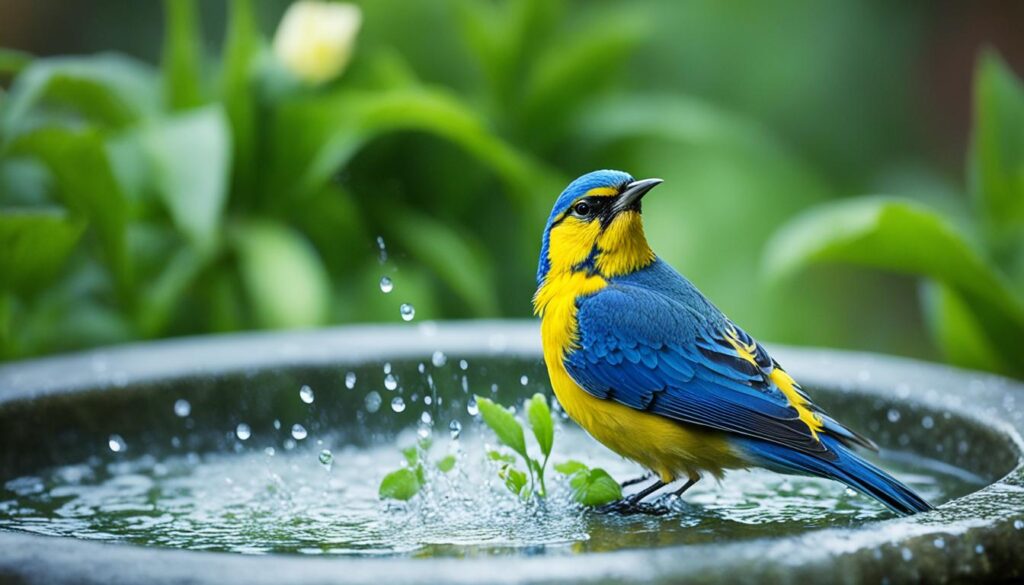

аккаунт для рекламы продажа аккаунтов соцсетей
купить аккаунт магазин аккаунтов
платформа для покупки аккаунтов гарантия при продаже аккаунтов
продажа аккаунтов соцсетей безопасная сделка аккаунтов
купить аккаунт маркетплейс аккаунтов соцсетей
профиль с подписчиками биржа аккаунтов
маркетплейс аккаунтов соцсетей услуги по продаже аккаунтов
Account Purchase Account Sale
Marketplace for Ready-Made Accounts Account Buying Service
Account Trading Service Gaming account marketplace
Accounts for Sale Account Trading Platform
Account Store Account Selling Service
Find Accounts for Sale Account Store
Account Trading Platform Sell Account
Account Exchange Service Marketplace for Ready-Made Accounts
Ready-Made Accounts for Sale Sell Pre-made Account
Account exchange Buy Pre-made Account
buy and sell accounts https://bestaccountsstore.com/
account sale account acquisition
account trading platform account exchange
guaranteed accounts https://buyaccountsdiscount.com/
website for buying accounts sell account
account selling service account marketplace
account acquisition sell accounts
account acquisition purchase ready-made accounts
online account store website for selling accounts
profitable account sales find accounts for sale
account market marketplace for ready-made accounts
database of accounts for sale https://accounts-buy.org
account market account exchange
accounts marketplace account trading service
find accounts for sale marketplace for ready-made accounts
ready-made accounts for sale find accounts for sale
buy accounts marketplace for ready-made accounts
account store sell pre-made account
sell account account trading platform
accounts market account trading
sell account account trading platform
account exchange service website for buying accounts
secure account purchasing platform sell account
find accounts for sale website for selling accounts
purchase ready-made accounts guaranteed accounts
secure account sales sell accounts
buy pre-made account account market
website for buying accounts top-social-accounts.org
marketplace for ready-made accounts https://accounts-offer.org/
gaming account marketplace https://accounts-marketplace.xyz
buy accounts https://buy-best-accounts.org
ready-made accounts for sale https://social-accounts-marketplaces.live
buy account https://accounts-marketplace.live
social media account marketplace https://social-accounts-marketplace.xyz
account catalog https://buy-accounts.space
gaming account marketplace https://buy-accounts-shop.pro/
account sale https://buy-accounts.live
website for selling accounts accounts-marketplace.online
account catalog https://social-accounts-marketplace.live/
account trading service https://accounts-marketplace-best.pro
купить аккаунт akkaunty-na-prodazhu.pro
купить аккаунт https://rynok-akkauntov.top/
маркетплейс аккаунтов kupit-akkaunt.xyz
купить аккаунт akkaunt-magazin.online
площадка для продажи аккаунтов https://akkaunty-market.live
покупка аккаунтов https://kupit-akkaunty-market.xyz/
площадка для продажи аккаунтов https://akkaunty-optom.live
купить аккаунт online-akkaunty-magazin.xyz
магазин аккаунтов https://akkaunty-dlya-prodazhi.pro/
продажа аккаунтов https://kupit-akkaunt.online/
buy facebook ad account https://buy-adsaccounts.work
buy facebook ads accounts buy facebook ads manager
buy facebook ads accounts https://buy-ad-account.top
buy aged facebook ads account https://ad-account-buy.top
buy facebook ad account https://buy-ads-account.work
buy a facebook ad account https://ad-account-for-sale.top
buying facebook account buy-ad-account.click
buy facebook profiles buy facebook accounts for ads
buy verified google ads accounts https://buy-ads-account.top
buy account google ads https://buy-ads-accounts.click/
buy facebook account buy facebook ads accounts
sell google ads account https://ads-account-for-sale.top
sell google ads account https://ads-account-buy.work
buy old google ads account https://buy-ads-invoice-account.top
buy google ads accounts https://buy-account-ads.work/
buy google ads buy google agency account